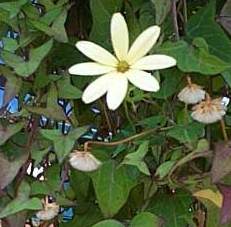Senecio macroglossus
Senecio macroglossus DC.
Family: Asteraceae
Common names: flowering Ivy, madeliefie-klimop, Cape Ivy, Natal Ivy,
Introduction
At first glance, Senecio macroglossus looks like a kind of ivy, but on closer inspection, the bright yellow daisy flowers amongst the foliage make it clear that it bears no real relationship to ivy whatsoever. Senecio macroglossus belongs in the Asteraceae (daisy family) whereas ivy, Hedera helix, belongs in the Araliaceae (ivy family), along with Cussonia species, the cabbage trees, and Schefflera.

Description
Description
Flowering ivy is an evergreen slender, twining but not tendril-climbing herbaceous perennial. It has smooth, thin, flexible branches bearing triangular or five-pointed ivy-like foliage. When creeping along the ground, the branches sometimes develop roots at the nodes. The leaves are a bright glossy green and are somewhat succulent. When broken, both the leaves and stems release a fresh lemony scent.

Large, conspicuous pale yellow daisy flowers are borne just about all year round, but mainly during the summer months. They remain open on cloudy or dull days, and are visited by bees, moths and wasps. The seeds are small and stick-like with a tuft of greyish-white bristles at one end (the pappus). Before being disturbed, they make quite decorative little dandelion-like tufty balls on the plant, but are soon carried off by the breeze.
Distribution and habitat
Distribution description
Senecio macroglossus is found on the eastern coast of South Africa from around Knysna in the Western Cape through East London in the Eastern Cape and further north into Lesotho and the KwaZulu-Natal south coast, where it is commonly found growing in forest and thicket margins.
Derivation of name and historical aspects
History
Senecio is a large and variable genus containing about 1250 species of which about 300 occur in southern Africa, the rest occurring mainly in South America and the rest of Africa. Senecios can be annual or perennial herbs, shrubs, subshrubs, small trees, vines or succulents. It is a member of the Asteraceae (daisy family), a huge family of some 1535 genera and 25 000 species spread all over the world and absent only from Antarctica. The name Senecio is derived from the Latin senex meaning old man and alluding to the whitish grey hairy pappus that is typical of, but not exclusive to this genus. Macroglossus means large-tongued (macro= large; glossa=tongue).
Growing Senecio macroglossus
Grow

Senecio macroglossus does well in sun or shade. It requires a neutral to slightly alkaline loamy soil that is well-drained. It grows best in fertile soil to which well-rotted compost is added regularly as a mulch, and it responds fast to foliar feeding. Senecio macroglossus is not hardy to frost although established plants in a protected position should be able to survive the odd cold snap to -1oC / 30oF but it is best suited to frost free gardens (zone 11 above 4oC / 40oF). It is very drought and heat tolerant. Senecio macroglossus is not as fast growing as its relative Senecio tamoides, the canary creeper, and it is much neater and longer lived. It is relatively easy to control and can be pruned when necessary to keep tidy or in late winter just before the new spring growth commences. Senecio macroglossus is relatively pest free, but aphids may sometimes be found on flower buds or on the young growing tips.
Flowering ivy makes an excellent hanging basket subject. At Kirstenbosch we have them growing in the large permanent hanging baskets in the Visitor Centre and outside the Restaurant. It is also a good trellis plant against a wall, even a west-facing wall, and is suitable for balconies and roof gardens where it will grow nearly 3m downwards if allowed to hang, or upwards if encouraged to climb up a trellis. It can also be used as a ground cover and is suitable for indoor cultivation. It mixes well with Aloe ciliaris and other climbing aloes where they can be grown together on a wire fence to create a living fence.
Senecio macroglossus can be propagated by cuttings or seed. Cuttings root easily in well-drained medium, like washed river sand, and placed in a cold frame or under intermittent mist. Seed can be sown in spring or during summer, in well-drained soil, but seedlings are prone to damping off and should therefore be sown thinly and treated with an appropriate fungicide.
Although Senecio macroglossus is not particularly well known or widely grown in South Africa, a silver variegated form has been grown in the United Kingdom, where it is a favourite conservatory subject, since the early 1900's. This variegated form is now also available from some South African nurseries.
Credits
Christien Malan
Kirstenbosch National Botanical Garden
February 2002
Plant Attributes:
Plant Type: Climber
SA Distribution: Eastern Cape, KwaZulu-Natal, Mpumalanga
Soil type: Sandy, Clay, Loam
Flowering season: Early Summer, Late Summer
PH: Acid, Alkaline, Neutral
Flower colour: Yellow
Aspect: Full Sun, Morning Sun (Semi Shade), Afternoon Sun (Semi Shade)
Gardening skill: Easy
Special Features:
Horticultural zones











Rate this article
Article well written and informative
Rate this plant
Is this an interesting plant?
Login to add your Comment
Back to topNot registered yet? Click here to register.